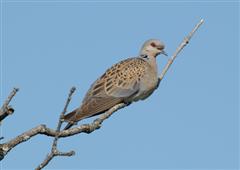Dove - European Turtle
Scientific Name: Streptopelia turtur
Sat, 19th July, 2025 - 3:17 am GMT
Sponsor Ads:

Alternative Name
Scientific Name: Streptopelia turturBasic Info
The European Turtle Dove displays pretty rusty brown feathers, a pinkish breast and neck barring, scaly wing covets and back, grayish cap and rump, and is slimmer and more finely built than the Turkish Turtle Dove. A hallmark of this lovely creature is its soft song which often sounds like a purr. Many state that the European Turtle Dove is heard more than it is seen.
Health
N/AHabitat
Various parts of the UKBehavior
A classic beauty the European Turtle Dove is a favorite among beginners and expert Dove fanciers. The domestic European Turtle Dove is not difficult to keep making it popular among novices who wish to raise exotic doves. Because they are active birds they require a medium to large flight cage. A European Turtle Dove must not be caged in a small cage. Research shows that the European Turtle Dove is breed easily in captivity provided they are given privacy.Origin
Isle of ManHistory
Originating from the Isle of Man The European Turtle Dove is also seen in the United Kingdom (UK) in the summer months at it is a summer migrating species. In the past large numbers of Turtle Doves could be seen in various parts of the UK, sometimes numbering in the hundreds in a single flock. It was not uncommon to see hundreds of Turtle Doves lined together on overhead cable lines. Today they are reaching the endangered list and have even reach the highest category of endangered birds in Britain the 'Red List'.Common Foods
They eat the seed diet common to most Dove species and also do well with live food from time to time.Sponsor Ads:
complex pick-up line: If I were to ask you for sex, would your answer be the same as the answer to this question?
Dove - European Turtle
Coded by: BGID® | ALL RIGHTS RESERVED Copyright © 2000-2025
Disclaimer | Privacy | Report Errors / Contact | Credits








 Why haven't we as a collective earth met with aliens yet?
Why haven't we as a collective earth met with aliens yet?  World EcoSystem - Biodiversity Changes - Who is on board and who isn
World EcoSystem - Biodiversity Changes - Who is on board and who isn  Homosexual behavior stems from the mind or genetics?
Homosexual behavior stems from the mind or genetics?  The Best Text Adventure You Will Ever Play! The official site:
The Best Text Adventure You Will Ever Play! The official site:  Mouthwash - Mouthrinse - Mouth Sores - Healing Infections - Gingivitis
Mouthwash - Mouthrinse - Mouth Sores - Healing Infections - Gingivitis  Treatment for Depression
Treatment for Depression  Ultra radical and violent Islamist group that even rivals Al Qaeda
Ultra radical and violent Islamist group that even rivals Al Qaeda  An idea to have teachers who want to carry guns to school undergo some level of police training will be left up to local school districts and police departments.
An idea to have teachers who want to carry guns to school undergo some level of police training will be left up to local school districts and police departments.